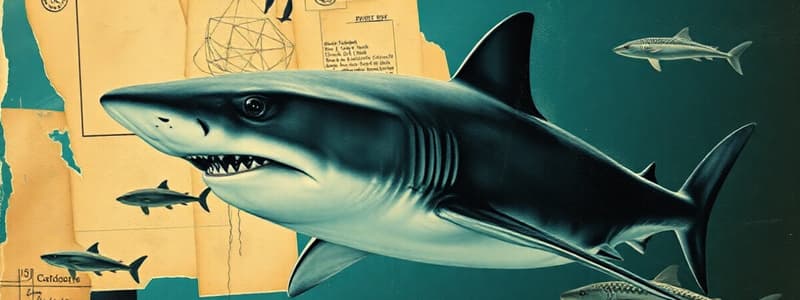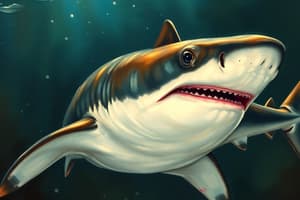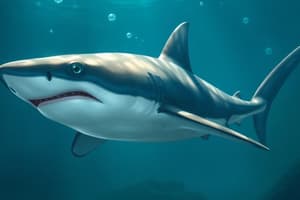Podcast
Questions and Answers
What characteristic defines sharks as apex predators?
What characteristic defines sharks as apex predators?
- Their position at the top of the food chain with few natural predators. (correct)
- Their ability to swim at high speeds in the water.
- Their highly developed sense of smell for detecting prey.
- Their skeletons made of flexible cartilage.
How does the shape of a shark's caudal fin enhance its swimming ability?
How does the shape of a shark's caudal fin enhance its swimming ability?
- The larger upper lobe generates more power for efficient forward movement. (correct)
- The larger lower lobe provides extra thrust for rapid acceleration.
- The symmetrical shape provides balance and stability in turbulent waters.
- The V-shape reduces water resistance, allowing for effortless gliding.
What is the primary advantage of a shark's cartilaginous skeleton over a bony skeleton?
What is the primary advantage of a shark's cartilaginous skeleton over a bony skeleton?
- Cartilage is denser than bone, providing better protection against predators.
- Cartilage provides better insulation in cold water environments compared to bone.
- Cartilage is more rigid than bone, enabling stronger muscle attachments for powerful swimming.
- Cartilage allows for greater flexibility and lighter body weight, enhancing agility. (correct)
Why is constant movement essential for many shark species in relation to their respiration?
Why is constant movement essential for many shark species in relation to their respiration?
What is the function of the ampullae of Lorenzini in sharks?
What is the function of the ampullae of Lorenzini in sharks?
How does a shark's sense of smell contribute to its hunting prowess?
How does a shark's sense of smell contribute to its hunting prowess?
What is the relationship between a shark's tooth shape and its diet?
What is the relationship between a shark's tooth shape and its diet?
What is the evolutionary advantage of sharks continuously replacing their teeth?
What is the evolutionary advantage of sharks continuously replacing their teeth?
How does coloration serve as an adaptation for sharks in their environment?
How does coloration serve as an adaptation for sharks in their environment?
Compared to many other fish, what is a distinct advantage sharks possess regarding oxygen uptake from water?
Compared to many other fish, what is a distinct advantage sharks possess regarding oxygen uptake from water?
Flashcards
Adaptation
Adaptation
The ability of a living organism to change or adapt to its surroundings.
Apex Predator
Apex Predator
A group of animals at the top of their food chain, having no natural predators except for humans.
Caudal Fin
Caudal Fin
The tail fin of a shark, shaped like an upside-down V. It helps them swim quickly and efficiently.
Cartilage
Cartilage
Signup and view all the flashcards
Ampullae of Lorenzini
Ampullae of Lorenzini
Signup and view all the flashcards
Sense of Smell
Sense of Smell
Signup and view all the flashcards
Jagged Teeth
Jagged Teeth
Signup and view all the flashcards
Flat Teeth
Flat Teeth
Signup and view all the flashcards
Tooth Replacement
Tooth Replacement
Signup and view all the flashcards
Camouflage
Camouflage
Signup and view all the flashcards
Study Notes
Shark Adaptations
- Sharks are apex predators, meaning they're at the top of their food chain, hunted only by humans. Other apex predators include lions, bald eagles, and crocodiles.
Swimming Abilities
- Sharks' bodies and fins are specially shaped for speed and efficiency in water.
- Their caudal fin (tail) is V-shaped, with the top section larger than the bottom, boosting swimming efficiency.
- Sharks have skeletons made of cartilage, not bone, which is lightweight and allows for quick movement.
- Sharks need to move constantly to breathe, absorbing oxygen from the water through their gills. They usually have more gills (five to seven) than other fish.
Sensing Electricity
- Sharks possess a sixth sense—they can detect the electricity produced by living things via specialized organs called ampullae of Lorenzini. This helps them find and hunt prey.
- Sharks have an extraordinary sense of smell, allowing the Great White Shark to detect blood in the water from considerable distances.
Jaws and Teeth
- Sharks' teeth are embedded in their gums and are continuously replaced throughout their lifespan.
- They grow in rows and sharks lose thousands of teeth over their lifetime.
- Tooth shapes vary depending on the shark species, from sharp, ripping teeth to flat, crushing teeth.
Camouflage
- Sharks' coloration typically features darker backs and lighter bellies (countershading).
- This countershading helps them blend into their environment, allowing for stealthy hunting.
Studying That Suits You
Use AI to generate personalized quizzes and flashcards to suit your learning preferences.




